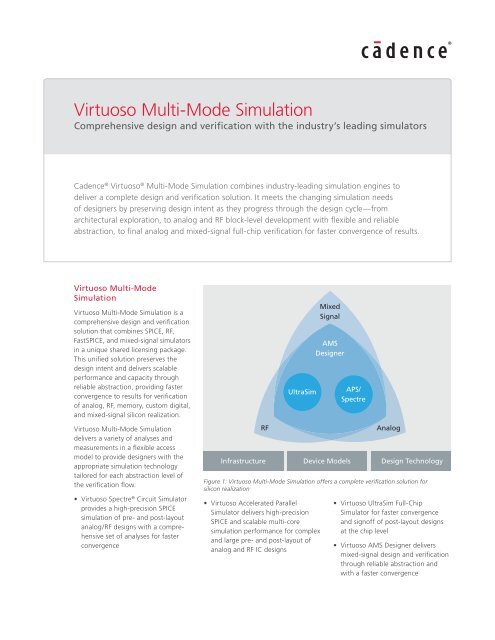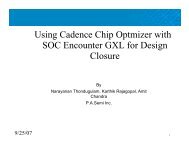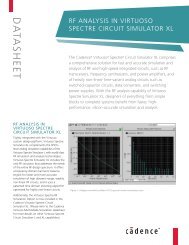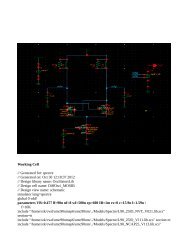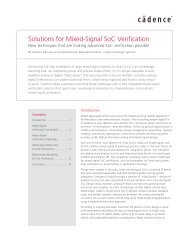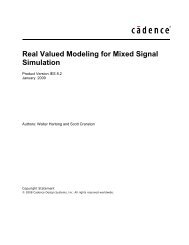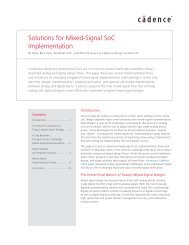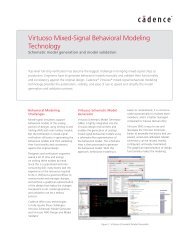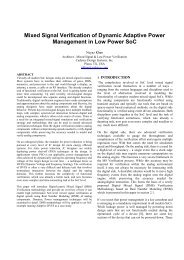Virtuoso Multi-Mode Simulation - Cadence Design Systems
Virtuoso Multi-Mode Simulation - Cadence Design Systems
Virtuoso Multi-Mode Simulation - Cadence Design Systems
You also want an ePaper? Increase the reach of your titles
YUMPU automatically turns print PDFs into web optimized ePapers that Google loves.
<strong>Virtuoso</strong> <strong>Multi</strong>-<strong>Mode</strong> <strong>Simulation</strong><br />
Comprehensive design and verification with the industry’s leading simulators<br />
<strong>Cadence</strong> ® <strong>Virtuoso</strong> ® <strong>Multi</strong>-<strong>Mode</strong> <strong>Simulation</strong> combines industry-leading simulation engines to<br />
deliver a complete design and verification solution. It meets the changing simulation needs<br />
of designers by preserving design intent as they progress through the design cycle—from<br />
architectural exploration, to analog and RF block-level development with flexible and reliable<br />
abstraction, to final analog and mixed-signal full-chip verification for faster convergence of results.<br />
<strong>Virtuoso</strong> <strong>Multi</strong>-<strong>Mode</strong><br />
<strong>Simulation</strong><br />
<strong>Virtuoso</strong> <strong>Multi</strong>-<strong>Mode</strong> <strong>Simulation</strong> is a<br />
comprehensive design and verification<br />
solution that combines SPICE, RF,<br />
FastSPICE, and mixed-signal simulators<br />
in a unique shared licensing package.<br />
This unified solution preserves the<br />
design intent and delivers scalable<br />
performance and capacity through<br />
reliable abstraction, providing faster<br />
convergence to results for verification<br />
of analog, RF, memory, custom digital,<br />
and mixed-signal silicon realization.<br />
<strong>Virtuoso</strong> <strong>Multi</strong>-<strong>Mode</strong> <strong>Simulation</strong><br />
delivers a variety of analyses and<br />
measurements in a flexible access<br />
model to provide designers with the<br />
appropriate simulation technology<br />
tailored for each abstraction level of<br />
the verification flow.<br />
• <strong>Virtuoso</strong> Spectre ® Circuit Simulator<br />
provides a high-precision SPICE<br />
simulation of pre- and post-layout<br />
analog/RF designs with a comprehensive<br />
set of analyses for faster<br />
convergence<br />
<strong>Virtuoso</strong> <strong>Multi</strong>-<strong>Mode</strong> <strong>Simulation</strong><br />
UltraSim<br />
Figure 1: <strong>Virtuoso</strong> <strong>Multi</strong>-<strong>Mode</strong> <strong>Simulation</strong> offers a complete verification solution for<br />
silicon realization<br />
• <strong>Virtuoso</strong> Accelerated Parallel<br />
Simulator delivers high-precision<br />
SPICE and scalable multi-core<br />
simulation performance for complex<br />
and large pre- and post-layout of<br />
analog and RF IC designs<br />
Mixed<br />
Signal<br />
AMS<br />
<strong>Design</strong>er<br />
APS/<br />
Spectre<br />
RF Analog<br />
Infrastructure Device <strong>Mode</strong>ls <strong>Design</strong> Technology<br />
• <strong>Virtuoso</strong> UltraSim Full-Chip<br />
Simulator for faster convergence<br />
and signoff of post-layout designs<br />
at the chip level<br />
• <strong>Virtuoso</strong> AMS <strong>Design</strong>er delivers<br />
mixed-signal design and verification<br />
through reliable abstraction and<br />
with a faster convergence
• <strong>Virtuoso</strong> AMS <strong>Design</strong>er Verification<br />
Option for advanced SoC verification<br />
These simulators support a common<br />
syntax, use common device model<br />
equations, and are fully integrated into<br />
the <strong>Virtuoso</strong> Analog <strong>Design</strong> Environment<br />
and the <strong>Cadence</strong> Incisive ® design and<br />
verification flow. The complementary<br />
feature sets of these simulators delivers<br />
improved productivity and facilitates<br />
adoption as designs move through the<br />
architecture, implementation, and verification<br />
stages—and as simulation needs<br />
change (see Figure 1).<br />
Benefits<br />
<strong>Design</strong> quality and convergence<br />
• Uses silicon-accurate device models<br />
across all simulators that are universally<br />
supported by all foundry process design<br />
kits (PDKs)<br />
• Supports shared syntax and<br />
abstractions across all engines and<br />
minimizes translation when moving<br />
among design domains<br />
• Features tight integration with the<br />
<strong>Virtuoso</strong> Analog <strong>Design</strong> Environment—<br />
with common use model, crossprobing,<br />
and backannotation<br />
capabilities<br />
• Features tight integration into the<br />
Incisive Logic <strong>Design</strong> Environment—<br />
with common-use model, debugging,<br />
waveform viewing, and language<br />
support<br />
• Provides a proven, comprehensive suite<br />
of high-precision analyses with a simple<br />
use model, delivering accurate results<br />
• Offers post-layout simulation and<br />
signoff analysis to ensure first-pass<br />
silicon realization success<br />
Scalability in performance<br />
• Delivers simulation performance for<br />
complex and large analog/RF, custom<br />
digital, and mixed-signal designs<br />
• Offers high-performance parallel<br />
simulation by harnessing the power<br />
of clusters of multi-core compute<br />
platforms to deliver peak performance<br />
Productivity<br />
• Provides high-performance and<br />
high-capacity transistor-level verification<br />
of a wide range of analog,<br />
custom-digital, and mixed-signal<br />
designs<br />
• Offers flexible and reliable abstraction<br />
for analog and digital-centric mixedsignal<br />
design flows, delivering faster<br />
simulation turnaround time<br />
Features<br />
Silicon-accurate modeling<br />
All <strong>Virtuoso</strong> <strong>Multi</strong>-<strong>Mode</strong> <strong>Simulation</strong><br />
engines use the same device model<br />
equations, eliminating model correlation<br />
issues and enabling faster convergence<br />
on simulation results. Common<br />
equations also ensure that new device<br />
model updates are available with all the<br />
simulators at the same time.<br />
Greater performance and capacity<br />
<strong>Virtuoso</strong> <strong>Multi</strong>-<strong>Mode</strong> <strong>Simulation</strong> engines<br />
provide the best combination of performance<br />
and capacity without sacrificing<br />
accuracy.<br />
Language and netlist support<br />
<strong>Virtuoso</strong> <strong>Multi</strong>-<strong>Mode</strong> <strong>Simulation</strong> supports<br />
a variety of abstraction methods. It is<br />
compatible with most commonly used<br />
SPICE input decks for both pre- and<br />
post-layout. It can natively read Spectre,<br />
SPICE, and Verilog-A netlist formats<br />
and device models. It also supports<br />
standard language inputs in Verilog-AMS,<br />
VHDL-AMS, Verilog-A, Verilog, and<br />
VHDL formats.<br />
Post-layout simulation<br />
Verification for post-layout designs has<br />
become increasingly important with<br />
advanced nanometer processes. For larger<br />
designs such as analog subsystems and<br />
full chips, the post-layout parasitics data<br />
is growing exponentially at 65nm and<br />
below.<br />
<strong>Virtuoso</strong> <strong>Multi</strong>-<strong>Mode</strong> <strong>Simulation</strong> offers<br />
a flexible solution for SPICE-level postlayout<br />
simulations of complex and large<br />
designs—with tens of thousands of<br />
circuit devices dominated by parasitics.<br />
<strong>Virtuoso</strong> <strong>Multi</strong>-<strong>Mode</strong> <strong>Simulation</strong> meets<br />
<strong>Virtuoso</strong> <strong>Multi</strong>-<strong>Mode</strong> <strong>Simulation</strong><br />
the SoC design verification challenge<br />
with a combination of unique hierarchical<br />
parasitic stitching techniques and<br />
an accurate frequency-based parasitic<br />
reduction algorithm. This approach<br />
delivers the performance and capacity for<br />
post-layout verification of large designs.<br />
It also provides an optimized power net<br />
simulation technique and methodology<br />
for analysis of effects such as IR drop,<br />
signal integrity, timing, and substrate<br />
degradation.<br />
<strong>Design</strong> reliability<br />
As gate oxide thickness and dimensions<br />
of scale shrink in IC design,<br />
reliability problems occur and need to be<br />
considered early in the design process.<br />
Some of the more problematic issues<br />
include negative bias temperature instability<br />
(NBTI) and hot carrier injection<br />
(HCI). These can lead to problems such as<br />
performance degradation, burn-in yield<br />
loss, leakage current increase leading to<br />
increased power consumption, and even<br />
functional failure of ICs.<br />
<strong>Virtuoso</strong> <strong>Multi</strong>-<strong>Mode</strong> <strong>Simulation</strong> provides<br />
a full-chip reliability simulation and<br />
analysis solution, enabling designers to<br />
consider reliability effects in the early<br />
stages of design and ensure silicon<br />
realization that has sufficient margins<br />
to function correctly over the product’s<br />
entire lifetime.<br />
Advanced analog and RF circuit<br />
analysis techniques<br />
The advanced architecture of <strong>Virtuoso</strong><br />
<strong>Multi</strong>-<strong>Mode</strong> <strong>Simulation</strong> uses proprietary<br />
techniques—including adaptive time step<br />
control, sparse matrix solving, and multicore<br />
processing—to provide high performance<br />
while maintaining signoff accuracy.<br />
It bridges the gap between manufacturability<br />
and time to market at advanced<br />
process nodes by providing a comprehensive<br />
set of statistical analysis tools<br />
tailored to IC design. Tight integration<br />
with the <strong>Virtuoso</strong> Analog <strong>Design</strong><br />
Environment offers user-friendly interactive<br />
setup and advanced visualization of<br />
statistical results.<br />
<strong>Virtuoso</strong> <strong>Multi</strong>-<strong>Mode</strong> <strong>Simulation</strong> provides<br />
the flexibility to combine design IP from<br />
different sources and abstraction levels<br />
necessary for the design and verification<br />
www.cadence.com 2
of today’s advanced mixed-signal SoCs. It<br />
accepts designs in combinations of various<br />
hardware description languages, allowing<br />
analog bottom-up and digital top-down<br />
design methodologies to link and enable<br />
complete analog/mixed-signal full-chip<br />
verification.<br />
Specifications<br />
Comprehensive device models<br />
• MOSFET models, including latest<br />
versions of BSIM3, BSIM4; PSP, HISIM,<br />
MOS9, MOS11, and EKV<br />
• Silicon-on-insulator (SoI), including<br />
latest versions of BTASOI, SSIMSOI<br />
BSIMSOI, BSIMSOI PD, and BSIM-IMG<br />
• High-voltage MOSFET models,<br />
including latest versions of HVMOS,<br />
LDMOS, and HiSim_HV<br />
• TMI models from TSMC<br />
• Bipolar junction transistor (BJT) models,<br />
including latest versions of VBIC,<br />
HICUM L0, HICUM L2, Mextram, HBT,<br />
and Gummel-Poon models<br />
• GaAS MESFET models, includes latest<br />
versions of GaAs, TOM2, TOM3, and<br />
Angelov<br />
• Rensselaer Polytechnic Institute’s (RPI)<br />
Poly and Amorphous Silicon Thin-Film<br />
models<br />
• Diode, JFET, FinFET, and Flash cell<br />
models<br />
• Verilog-A compact device models<br />
• Specialized reliability models (AgeMOS)<br />
for hot carrier injection (HTI) and<br />
negative bias temperature instability<br />
(NBTI) analysis<br />
• Platform support<br />
• x86 32-bit: Redhat Enterprise V5 and<br />
V6, SUSE Linux 9 and 10<br />
• x86 64-bit: Redhat Enterprise V4, V5,<br />
and V6, SUSE Linux 9 and 10<br />
• Sun Solaris 10<br />
<strong>Virtuoso</strong> <strong>Multi</strong>-<strong>Mode</strong> <strong>Simulation</strong><br />
www.cadence.com 3
<strong>Virtuoso</strong> Spectre Circuit Simulator<br />
<strong>Virtuoso</strong> Spectre Circuit Simulator is an<br />
industry-proven, fast, SPICE-accurate<br />
simulator for tough analog, radio<br />
frequency (RF), and mixed-signal circuit<br />
simulation and device characterization.<br />
It is tightly integrated with the <strong>Virtuoso</strong><br />
custom design platform and provides a<br />
comprehensive set of detailed transistorlevel<br />
analyses in multiple domains for<br />
faster convergence on design goals.<br />
Its superior architecture allows for low<br />
memory consumption and high-capacity<br />
analysis.<br />
Benefits<br />
• Provides high-performance,<br />
high-capacity SPICE-level analog and RF<br />
simulation with out-of-the-box tuning<br />
for accuracy and faster convergence<br />
• Facilitates the tradeoff between<br />
accuracy and performance through<br />
user-friendly simulation setup<br />
applicable to the most complex analog<br />
and custom-digital ICs<br />
• Enables accurate and efficient<br />
post-layout simulation with parasitics,<br />
S-Parameter models (n-port), and lossy<br />
coupled transmission lines (mtline)<br />
• Performs application-specific analysis<br />
of RF performance parameters (spectral<br />
response, gain compression, intermodulation<br />
distortion, impedance<br />
matching, stability, and isolation)<br />
• Offers advanced statistical analysis<br />
(Smart, MonteCarlo, and DCmatch)<br />
to help design companies improve<br />
the manufacturability and yield of ICs<br />
at advanced process nodes without<br />
sacrificing time to market<br />
• Delivers fast interactive simulation<br />
setup, cross-probing, visualization, and<br />
post-processing of simulation results<br />
through tight integration with <strong>Virtuoso</strong><br />
Analog <strong>Design</strong> Environment<br />
• Ensures higher design quality using<br />
silicon-accurate, foundry-certified<br />
device models shared across the<br />
simulators within the <strong>Virtuoso</strong><br />
<strong>Multi</strong>-<strong>Mode</strong> <strong>Simulation</strong> solution<br />
Features<br />
Production-proven circuit simulation<br />
techniques<br />
<strong>Virtuoso</strong> Spectre Circuit Simulator uses<br />
proprietary techniques—including<br />
adaptive time step control, sparse matrix<br />
solving, and multi-processing of MOS<br />
models—to provide high performance<br />
while maintaining signoff accuracy. It<br />
includes native support for both Spectre<br />
and SPICE syntax, giving users the flexibility<br />
to use Spectre technology for any<br />
design flow without worrying about the<br />
design format. Additionally, it converges<br />
to results that are “silicon-accurate” by<br />
modeling extensive physical effects in<br />
devices for deep sub-micron processes.<br />
Comprehensive statistical analysis<br />
<strong>Virtuoso</strong> Spectre Circuit Simulator bridges<br />
the gap between manufacturability and<br />
time to market at advanced process<br />
nodes by providing a comprehensive set<br />
of statistical analysis tools tailored to IC<br />
<strong>Virtuoso</strong> <strong>Multi</strong>-<strong>Mode</strong> <strong>Simulation</strong><br />
Figure 2: <strong>Virtuoso</strong> Spectre Circuit Simulator delivers significant performance and capacity for<br />
accurate analog simulation for silicon realization<br />
design. Advanced Monte Carlo algorithms<br />
enable smart selection of process and<br />
design parameters to characterize<br />
the yield in one-tenth of the required<br />
simulation runs (see Figure 2). The DC<br />
Match capability efficiently analyzes local<br />
process mismatch effects and identifies<br />
the yield-limiting devices and parameters.<br />
Tight integration between <strong>Virtuoso</strong><br />
Spectre Circuit Simulator and <strong>Virtuoso</strong><br />
Analog <strong>Design</strong> Environment offers userfriendly<br />
interactive setup and advanced<br />
visualization of statistical results.<br />
Transient noise analysis<br />
<strong>Virtuoso</strong> Spectre Circuit Simulator<br />
provides transient noise analysis for<br />
accurate calculation of the large signal<br />
noise in nonlinear non-periodic circuits.<br />
All noise types are supported—including<br />
thermal, shot, and flicker. The analysis is<br />
built on top of Spectre Circuit Simulator’s<br />
industry-proven accurate transient engine.<br />
Built-in Verilog-A and MDL<br />
<strong>Virtuoso</strong> Spectre Circuit Simulator offers<br />
design abstraction for faster convergence<br />
on results, including behavioral modeling<br />
capabilities in full compliance with<br />
Verilog-A 2.0. The compiled Verilog-A<br />
www.cadence.com 4
implementation is optimized for compact<br />
device models offering comparable<br />
performance to built-in device models.<br />
In addition to supporting standard SPICE<br />
measurement functions (.measure),<br />
it offers a measurement description<br />
language (MDL) to automate cell and<br />
library characterization. <strong>Virtuoso</strong> Spectre<br />
MDL enables the designer to post-process<br />
the results and tune the simulator to<br />
provide the best performance/accuracy<br />
tradeoff for a specific measurement.<br />
Advanced device modeling<br />
and support<br />
<strong>Virtuoso</strong> Spectre Circuit Simulator<br />
supports MOS, BJT, specialty transistor<br />
models, resistors, capacitors, inductors,<br />
transformers and magnetic cores,<br />
lossy and lossless transmission lines,<br />
independent and controlled voltage and<br />
current sources, and Z and S domain<br />
sources.<br />
The user-defined model interface includes<br />
a compiled model interface (CMI) that<br />
is shared across all platform simulators.<br />
It allows for the rapid inclusion of userdefined<br />
models for a “model once, use<br />
everywhere” capability. It offers a curve<br />
tracer analysis capability for rapid model<br />
development and debugging.<br />
RF simulation<br />
<strong>Virtuoso</strong> Spectre Circuit Simulator<br />
provides a proven and widely adopted set<br />
of comprehensive RF analyses capabilities.<br />
• Harmonic balance analysis, optimized<br />
for high dynamic range, high-capacity<br />
RF circuits with distributed components<br />
• Periodic and quasi-periodic steadystate<br />
analysis based on the <strong>Cadence</strong><br />
patented time-domain shooting<br />
Newton algorithm, optimized for<br />
strongly non-linear circuits<br />
• Envelope following analysis supporting<br />
all analog and digital modulation<br />
techniques<br />
• Rapid IP2 and IP3 calculation based on<br />
perturbation technology<br />
• Periodic noise analysis for the accurate<br />
calculation of noise in non-linear time<br />
variant circuits with detailed analysis<br />
options (modulated noise, sampled<br />
noise, and jitter)<br />
• Noise and distortion summary to<br />
identify the contribution of each device<br />
to the total output noise, harmonic, or<br />
inter-modulation distortion<br />
• Small signal analysis: AC, transfer<br />
function, S-Parameters, and stability<br />
based on a periodic or quasi-periodic<br />
operating point<br />
• Monte Carlo, corner-case, and<br />
parametric sweep analysis<br />
Noise-aware PLL analysis<br />
An automated flow for time-domain<br />
and jitter analysis of integer-N and<br />
fractional-N phase locked loops (PLL)<br />
blocks. The flow significantly speeds<br />
up PLL verification using abstractiontransistor-calibrated<br />
nonlinear models<br />
for sub-components of the PLL. The flow<br />
enables PLL designers to capture the<br />
effect of circuit nonlinearity on closed-<br />
<strong>Virtuoso</strong> <strong>Multi</strong>-<strong>Mode</strong> <strong>Simulation</strong><br />
loop PLL noise and test for complicated<br />
performance parameters such as injection<br />
pulling.<br />
RF measurment library<br />
The library consists of RF measurement<br />
elements such as noise figure and<br />
inter-modulation distortion tailored for<br />
specific RF blocks (amplifiers, mixers,<br />
and oscillators). <strong>Design</strong>ers can insert the<br />
measurements directly on the schematics<br />
simplifying simulation setup and postprocessing.<br />
The measurement element<br />
will automatically set up the simulation,<br />
perform any necessary post-processing<br />
and plot the required waveforms. Users<br />
can augment the library by defining their<br />
own measurements.<br />
Co-simulation with Simulink<br />
The MathWorks Simulink interface to<br />
<strong>Virtuoso</strong> Spectre Circuit Simulator offers<br />
system and circuit designers a unique<br />
integrated environment for design and<br />
verification. <strong>Design</strong>ers can insert their<br />
analog and RF schematics and postlayout<br />
netlist directly in the system-level<br />
block diagram and run a co-simulation<br />
between Simulink and <strong>Virtuoso</strong> Spectre<br />
technologies. <strong>Design</strong>ers can reuse the<br />
Figure 3: <strong>Virtuoso</strong> Spectre Simulator offers fast signoff-accurate analysis of voltagecontrolled<br />
oscillators<br />
www.cadence.com 5
same Simulink testbench from systemlevel<br />
design to post-layout verification,<br />
minimizing the unnecessary format<br />
conversion while maintaining accuracy<br />
throughout the design flow.<br />
<strong>Virtuoso</strong> <strong>Multi</strong>-<strong>Mode</strong> <strong>Simulation</strong><br />
toolbox for MATLAB<br />
The <strong>Virtuoso</strong> <strong>Multi</strong>-<strong>Mode</strong> <strong>Simulation</strong><br />
toolbox for MATLAB reads PSF and<br />
SST2 files directly in MATLAB. Users<br />
benefit from the rich set of MATLAB<br />
mathematical functions to post-process<br />
simulation results from <strong>Virtuoso</strong> Spectre<br />
Circuit Simulator, <strong>Virtuoso</strong> UltraSim<br />
Full-Chip Simulator, and <strong>Virtuoso</strong> AMS<br />
<strong>Design</strong>er with flexible analog simulation.<br />
All sweep types are supported in the<br />
toolbox, including Monte Carlo and<br />
parametric. Special data structures are<br />
used to store RF signals and harmonics<br />
resulting from PSS and QPSS analysis.<br />
Furthermore, the <strong>Virtuoso</strong> <strong>Multi</strong>-<strong>Mode</strong><br />
<strong>Simulation</strong> toolbox complements the<br />
rich MATLAB libraries with communication<br />
product-specific post-processing<br />
functions such as Fast Fourier Transform,<br />
third-order intercept point, and 1-dB gain<br />
compression point.<br />
Post-layout simulation<br />
<strong>Virtuoso</strong> Spectre Circuit Simulator enables<br />
analog and RF block and subsystem<br />
post-layout verification at near the speed<br />
of pre-layout simulation. An accurate<br />
parasitic reduction technique enhances<br />
the simulation performance of parasiticdominant<br />
circuits by a significant amount<br />
over traditional SPICE-level simulation.<br />
The technology enables designers to<br />
trade-off accuracy and performance using<br />
a simple user-friendly setup.<br />
Specifications<br />
Comprehensive circuit analyses<br />
• DC, AC, and transient analysis<br />
• Noise, transfer function, and sensitivity<br />
analysis<br />
• Transient noise analysis<br />
• Native reliability analysis<br />
• Monte Carlo and parametric statistical<br />
support<br />
• Full support for sweeping analysis and<br />
circuit parameters<br />
• Built-in measurement description<br />
language<br />
• Harmonic balance analysis<br />
• Periodic and quasi-periodic steady<br />
state analysis (PSS and QPSS) based on<br />
shooting Newton technology<br />
• Periodic and quasi-periodic noise<br />
analysis<br />
• Periodic and quasi-periodic small signal<br />
analysis<br />
• Periodic stability analysis<br />
• Time-domain and frequency-domain<br />
envelope analysis<br />
• Perturbation-based rapid IP2 and IP3<br />
• Noise and distortion summaries<br />
• Co-simulation with Simulink from The<br />
MathWorks<br />
<strong>Virtuoso</strong> <strong>Multi</strong>-<strong>Mode</strong> <strong>Simulation</strong><br />
• <strong>Virtuoso</strong> <strong>Multi</strong>-<strong>Mode</strong> <strong>Simulation</strong><br />
toolbox for MATLAB from the<br />
MathWorks<br />
<strong>Design</strong> inputs/outputs<br />
• <strong>Virtuoso</strong> Spectre netlist format<br />
• SPICE netlist format<br />
• Verilog-A 2.0<br />
• S-Parameter data files<br />
• PSF waveform format<br />
Figure 4: <strong>Virtuoso</strong> <strong>Multi</strong>-<strong>Mode</strong> <strong>Simulation</strong> RF analysis enables fast transceiver verification<br />
www.cadence.com 6
<strong>Virtuoso</strong> Accelerated Parallel Simulator<br />
<strong>Virtuoso</strong> Accelerated Parallel Simulator,<br />
a key component of the <strong>Virtuoso</strong><br />
<strong>Multi</strong>-<strong>Mode</strong> <strong>Simulation</strong>, provides<br />
advanced performance for the next<br />
generation of analog and RF simulation.<br />
It delivers significant scalable performance<br />
and capacity at full Spectre<br />
accuracy across a broad range of complex<br />
analog, RF and mixed-signal blocks, and<br />
sub-systems with sizes up to millions<br />
of transistors and passive and parasitic<br />
elements. <strong>Virtuoso</strong> Accelerated Parallel<br />
Simulator provides all the transistor-level<br />
analysis capabilities available in <strong>Virtuoso</strong><br />
Spectre Circuit Simulator. Additionally, its<br />
proprietary parallel simulation technology<br />
delivers scalable multi-core processing<br />
capability on modern multi-core compute<br />
platforms.<br />
Benefits<br />
• Provides significant single-core<br />
performance with an identical use<br />
model and full Spectre accuracy for<br />
everyday simulation of complex and/<br />
or large block designs, leading to faster<br />
convergence<br />
• Enables high-precision simulation for<br />
large post-layout analog and RF designs<br />
and subsystems dominated by parasitic<br />
devices<br />
• Delivers scalable performance<br />
leveraging a single machine or<br />
cluster of machines with multi-core<br />
architectures, allowing higher levels of<br />
analog design integration and verification<br />
and a quick turnaround time on<br />
simulation<br />
• Enables fast and accurate analysis<br />
of complete transceivers and large<br />
post-layout RF IC blocks by significantly<br />
improving the performance and<br />
capacity of harmonic balance analysis<br />
using a multi-core compute platform<br />
Features<br />
• Supports all analyses capabilities<br />
offered in the <strong>Virtuoso</strong> Spectre Circuit<br />
Simulator<br />
• Offers advanced parallel simulation on<br />
a single multi-core compute platform<br />
• Supports distributed, advanced parallel<br />
simulation across a cluster of multi-core<br />
compute platforms<br />
• Enables parasitic stitching and<br />
reduction for post-layout design and<br />
verification, providing additional<br />
performance gain for analog and RF<br />
designs dominated by parasitics<br />
• <strong>Multi</strong>-core harmonic balance and<br />
envelope analysis<br />
• Full support of RF components and<br />
measurements library with identicaluse<br />
model to standard RF simulation<br />
capabilities in the <strong>Virtuoso</strong> Spectre<br />
environment<br />
Specifications<br />
Comprehensive device models<br />
• MOSFET models, including latest<br />
versions of BSIM3, BSIM4; PSP, HISIM,<br />
high-voltage MOS (HVMOS), MOS9,<br />
MOS11, and EKV<br />
• Silicon-on-insulator (SOI), including<br />
latest versions of BTASOI, SSIMSOI<br />
BSIMSOI, BSIMSOI PD, and BSIM-IMG<br />
• Bipolar junction transistor (BJT)<br />
models, including latest versions of<br />
VBIC, HICUM, Mextram, HBT, and<br />
Gummel-Poon models<br />
• Diode, JFET<br />
• GaAS MESFET models, includes latest<br />
versions of GaAs, TOM2, TOM3, and<br />
Angelov<br />
• Rensselaer Polytechnic Institute’s (RPI)<br />
Poly and Amorphous Silicon Thin-Film<br />
models<br />
• Verilog-A compact device models<br />
<strong>Virtuoso</strong> <strong>Multi</strong>-<strong>Mode</strong> <strong>Simulation</strong><br />
• Specialized reliability models (AgeMOS)<br />
for hot carrier injection (HTI) and<br />
negative bias temperature instability<br />
Circuit analysis<br />
• DC, AC, and transient analysis<br />
• Transient noise analysis<br />
• Native reliability analysis<br />
• Monte Carlo and parametric statistical<br />
support<br />
• Full support for sweeping analysis and<br />
circuit parameters<br />
• Built-in measurement description<br />
language<br />
• RF harmonic balance analysis<br />
• RF shooting Newton analysis<br />
• RF FAST envelope analysis supporting<br />
all modulation schemes<br />
• RF noise and small signal analysis based<br />
on harmonic balance solution<br />
<strong>Design</strong> inputs/outputs<br />
• <strong>Virtuoso</strong> Spectre netlist format<br />
• SPICE netlist format<br />
• Verilog-A<br />
• S-Parameter data files<br />
• PSF waveform format<br />
www.cadence.com 7
<strong>Virtuoso</strong> UltraSim Full-Chip Simulator<br />
<strong>Virtuoso</strong> UltraSim Full-Chip<br />
Simulator<br />
The <strong>Virtuoso</strong> UltraSim Full-Chip Simulator<br />
is a high-performance transistor-level<br />
FastSPICE circuit simulator for pre- and<br />
post-layout verification of memories,<br />
custom-digital, and analog/mixed-signal<br />
SoC designs. It delivers the capacity,<br />
accuracy, and speed required for verification<br />
using abstraction where appropriate<br />
while preserving the design intent.<br />
It uses true hierarchical simulation and a<br />
patented isomorphic and adaptive partitioning<br />
algorithms<br />
Benefits<br />
• Accelerates pre-and post-layout<br />
simulation for a wide range of<br />
applications from blocks to full-chip<br />
SoCs (see Figure 5)<br />
• Provides a comprehensive set of<br />
transistor-level analysis covering<br />
electrical rule check (ERC), power,<br />
timing, and nodal activity (see Figure 6)<br />
• Handles large post-layout designs using<br />
a combination of unique hierarchical<br />
parasitic stitching techniques and an<br />
accurate frequency-based parasitic<br />
reduction algorithm<br />
• Supports multiple simulation<br />
abstraction modes (SPICE, analog,<br />
mixed-signal, and digital), enabling the<br />
user to locally tune performance and<br />
accuracy settings for different blocks in<br />
the design<br />
• Flexible easy-to-use controls for<br />
providing adequate tradeoff between<br />
accuracy and simulation speed<br />
• Plugs smoothly into design and verification<br />
flows through integration with<br />
<strong>Virtuoso</strong> Analog <strong>Design</strong> Environment<br />
and command-line environments<br />
PM<br />
Features<br />
Digital<br />
Testbench<br />
d<br />
Mem<br />
D<br />
Analog<br />
Compatible with SPICE, Spectre,<br />
Verilog-A, and SPEF<br />
D<br />
a<br />
a<br />
Hierarchical<br />
Netlist<br />
Parasitics<br />
DSPF, SPEF<br />
<strong>Virtuoso</strong> UltraSim Full-Chip Simulator<br />
is compatible with most types of SPICE<br />
input decks for both pre- and post-layout.<br />
Natively reads <strong>Virtuoso</strong> Spectre format<br />
netlists and models, and uses the same<br />
views within <strong>Virtuoso</strong> Analog <strong>Design</strong><br />
Environment, making it easy to adopt in<br />
<strong>Virtuoso</strong> Spectre-based design flows.<br />
<strong>Virtuoso</strong> <strong>Multi</strong>-<strong>Mode</strong> <strong>Simulation</strong><br />
Figure 5: <strong>Virtuoso</strong> UltraSim post-layout verification and analysis for silicon realization<br />
Electrical<br />
Rule Check<br />
MOSFETs connected<br />
across different<br />
power domains<br />
Floating gates,<br />
floating bulks, and<br />
dangling nodes<br />
MOSFET shorting<br />
VDD and GND<br />
Always conducting<br />
MOSFET<br />
NMOS-VDD, PMOS-<br />
GND connections<br />
Forward-biased<br />
substrate<br />
Power<br />
Analysis<br />
Average, RMS,<br />
peak-to-peak power<br />
and total energy<br />
at the chip and<br />
block level<br />
Current hot spots<br />
Wasted capacitive<br />
currents<br />
Floating<br />
gate-induced<br />
leakage<br />
Static: DC<br />
leakage path<br />
Post-layout simulation<br />
When used in conjunction with <strong>Cadence</strong><br />
post-layout products, <strong>Virtuoso</strong> UltraSim<br />
Full-Chip Simulator provides a means<br />
for exploration and validation of such<br />
effects as electromigration, IR drop, signal<br />
integrity, and substrate degradation.<br />
It also has built-in, state-of-the-art,<br />
S-Parameter–based parasitic reduction<br />
for faster simulation with minimal loss in<br />
accuracy.<br />
www.cadence.com 8<br />
Stitching<br />
AMS<br />
<strong>Design</strong>er<br />
and<br />
UltraSim<br />
Electromigration/<br />
IR Drop Analysis<br />
Timing<br />
Analysis<br />
Excessive rise and<br />
fall times<br />
Setup, hold, pulse<br />
width and timing<br />
edge errors<br />
User-defined<br />
measurements using<br />
SPICE measure<br />
Figure 6: <strong>Virtuoso</strong> UltraSim transistor-level full-chip analysis for silicon realization<br />
Functional<br />
Verification<br />
Timing<br />
Power<br />
Reliability<br />
Node Activity<br />
Analysis<br />
Glitch check<br />
Overshoot,<br />
undershoot,<br />
toggling, and note<br />
capacitance<br />
Signal probablility of<br />
being high<br />
or low<br />
Static: device<br />
parameters, voltage<br />
checks, and high-<br />
impedance nodes
<strong>Design</strong> reliability simulation<br />
<strong>Virtuoso</strong> UltraSim Full-Chip Simulator<br />
provides a robust set of analyses capable<br />
of predicting and validating timing,<br />
power, and reliability. It is the only<br />
FastSPICE simulator capable of simulating<br />
hot carrier injection (HCI) and negative<br />
bias temperature instability (NBTI)—key<br />
stress effects that must be taken into<br />
account for high-performance advanced<br />
node designs.<br />
Specifications<br />
<strong>Design</strong> inputs and outputs<br />
• <strong>Virtuoso</strong> Spectre netlist<br />
• SPICE netlist format<br />
• DSPF/SPEF parasitic formats<br />
• Verilog-A<br />
• SST2 waveform format<br />
• PSF and PSF XL waveform format<br />
• FSDB format<br />
• Veritools waveform format<br />
• <strong>Virtuoso</strong> UltraSim/Verilog<br />
– Verilog-HDL IEEE 1364<br />
– PLI 1.0, VPI (PLI 2.0)<br />
– SDF<br />
• AMS-<strong>Virtuoso</strong> UltraSim<br />
– Verilog-AMS 2.0<br />
– VHDL-AMS 1076.1<br />
– Verilog (IEEE 1364-1995, IEEE<br />
1364-2001 extensions)<br />
– VHDL (IEEE 1076-1987, IEEE<br />
1076-1993, IEEE 1076.4-2000 [VITAL<br />
2000])<br />
– PLI 1.0, VPI (PLI 2.0)<br />
– SDF<br />
– SystemC , SystemVerilog<br />
<strong>Virtuoso</strong> <strong>Multi</strong>-<strong>Mode</strong> <strong>Simulation</strong><br />
www.cadence.com 9
<strong>Virtuoso</strong> AMS <strong>Design</strong>er Simulator<br />
<strong>Virtuoso</strong> AMS <strong>Design</strong>er provides an<br />
advanced mixed-signal simulation<br />
solution for the design and verification<br />
of analog, RF, memory, and mixed-signal<br />
silicon realization. It is integrated with<br />
the <strong>Virtuoso</strong> full-custom environment<br />
as well as the Incisive functional verification<br />
platform. <strong>Virtuoso</strong> AMS <strong>Design</strong>er<br />
provides a single simulation executable<br />
with flexible abstraction support through<br />
the standard mixed-signal languages<br />
(Verilog-AMS and VHDL-AMS) and/<br />
or SPICE-level models. As the bridge<br />
between analog and digital domain, it<br />
enables users to choose the right analog<br />
solver for the right design or verification<br />
task. <strong>Design</strong>ers can choose Spectre<br />
technology for SPICE-accurate blocklevel<br />
analog and RF designs, <strong>Virtuoso</strong><br />
Accelerated Parallel Simulator for SPICEaccurate,<br />
scalable high performance, or<br />
<strong>Virtuoso</strong> UltraSim Full-Chip Simulator for<br />
silicon realization.<br />
<strong>Virtuoso</strong> AMS <strong>Design</strong>er is fully configurable<br />
across the design and verification<br />
domains, offering the right simulation<br />
technology and environment for every<br />
stage in the design and verification cycle.<br />
Benefits<br />
• Ensures design quality with proven<br />
<strong>Virtuoso</strong> analog and Incisive digital<br />
simulation technologies<br />
• Supports both analog design flow use<br />
models in <strong>Virtuoso</strong> Analog <strong>Design</strong><br />
Environment as well as digital verification<br />
use models in the Incisive<br />
environment<br />
• Supports both top-down and<br />
bottom-up methodologies to quickly<br />
detect and fix design failures early<br />
in the design cycle, helping to meet<br />
tapeout schedules<br />
• Extensive language support allows<br />
higher level of abstraction and<br />
accelerates simulation to achieve faster<br />
turnaround time<br />
• Supports simulation of RF circuits<br />
at full SPICE accuracy by combining<br />
envelope analysis of RF transceivers<br />
with digital baseband simulation for<br />
faster convergence of results<br />
Features<br />
Methodology-independent design<br />
convergence<br />
<strong>Virtuoso</strong> AMS <strong>Design</strong>er provides the<br />
flexibility to combine IP from different<br />
sources and in different formats for<br />
today’s SoC designs. It does more than<br />
just co-simulate analog and digital blocks.<br />
By treating <strong>Virtuoso</strong> Schematic Editor<br />
blocks and textual descriptions equally,<br />
<strong>Virtuoso</strong> AMS <strong>Design</strong>er allows different<br />
points of data entry. It accepts descriptions<br />
in the standard language formats<br />
of Verilog-AMS, VHDL-AMS, Verilog-A,<br />
Verilog, VHDL, and SystemC, as well as<br />
SPICE and <strong>Virtuoso</strong> Spectre simulation, or<br />
any combination of these languages. This<br />
allows bottom-up and top-down design<br />
methodologies to converge into a fully<br />
functional design.<br />
AMS Block and Top-Down Verification<br />
<strong>Virtuoso</strong> AMS <strong>Design</strong>er<br />
<strong>Virtuoso</strong><br />
Spectre L/LX<br />
<strong>Multi</strong>-Language Debugging<br />
<strong>Virtuoso</strong> AMS <strong>Design</strong>er<br />
<strong>Virtuoso</strong><br />
UltraSim X/XL<br />
Incisive <strong>Design</strong><br />
Team Simulator<br />
Incisive <strong>Design</strong><br />
Team Simulator<br />
AMS Full-Chip Verification<br />
<strong>Virtuoso</strong> <strong>Multi</strong>-<strong>Mode</strong> <strong>Simulation</strong><br />
Unified Waveform<br />
Figure 7: <strong>Virtuoso</strong> AMS <strong>Design</strong>er verification flow addresses silicon-realization<br />
requirements throughout the design cycle<br />
Different levels of abstraction, such as<br />
Verilog-AMS or VHDL-AMS behavioral<br />
models and schematic representation, are<br />
easily interchangeable to allow the design<br />
to change over time from full behavioral<br />
to full transistor. The entire design<br />
is configured using the hierarchy editor,<br />
which facilitates the viewing and design<br />
preparation of a complex mixed-signal<br />
design. Automatically inserted interface<br />
elements are used to translate signals<br />
from one domain to the next, leaving<br />
the user free to simulate with different<br />
design configurations to easily tradeoff<br />
simulation speed for simulation accuracy.<br />
<strong>Virtuoso</strong> AMS <strong>Design</strong>er also supports IP<br />
encryption using RSA technology, which<br />
allows the user to establish both IP reuse<br />
and virtual-prototyping methodologies.<br />
Integrated with proven <strong>Virtuoso</strong> and<br />
Incisive simulation technologies<br />
<strong>Virtuoso</strong> AMS <strong>Design</strong>er is a single<br />
executable mixed-signal simulator based<br />
on the proven technology of <strong>Virtuoso</strong><br />
Spectre, <strong>Virtuoso</strong> Accelerated Parallel<br />
www.cadence.com 10
Simulator, UltraSim Full-Chip Simulator,<br />
and the Incisive digital simulation capabilities.<br />
Analog-centric flow with <strong>Virtuoso</strong><br />
<strong>Virtuoso</strong> AMS <strong>Design</strong>er is tightly<br />
integrated with the <strong>Virtuoso</strong> Analog<br />
<strong>Design</strong> Environment for mixed-signal<br />
block design. It uses native Analog <strong>Design</strong><br />
Environment netlisting technologies to<br />
combine schematics and behavioral views,<br />
enabling users to independently manage<br />
the level of abstraction of each block.<br />
The entire design is configured using<br />
the hierarchy editor, which facilitates<br />
the viewing and design preparation of a<br />
complex mixed-signal design.<br />
• Using <strong>Virtuoso</strong> AMS <strong>Design</strong>er with<br />
<strong>Virtuoso</strong> Spectre Simulatoror, <strong>Virtuoso</strong><br />
Accelerated Parallel Simulator ensures<br />
that the user gets golden simulation<br />
results for performance measurements<br />
• Advanced circuit analysis such as<br />
Monte Carlo can be performed with<br />
the AMS/Spectre interface, leveraging<br />
the performance benefits of behavioral<br />
models and using the same setup as<br />
the Spectre tool<br />
• Advanced-model validation capabilities<br />
allow users to verify their circuit<br />
design against a behavioral model<br />
automatically by comparing simulation<br />
waveforms<br />
Digital-centric flow with Incisive<br />
<strong>Virtuoso</strong> AMS <strong>Design</strong>er works natively in<br />
the Incisive environment for digital-centric<br />
verification. A single control file is used to<br />
define how analog blocks are integrated<br />
into the digital SoC. Analog and RTL<br />
blocks can be easily interchanged to trade<br />
off accuracy and performance. It supports<br />
all features in the Incisive environment like<br />
testbench analysis, Specman ® technology,<br />
and verification planning.<br />
• Automatically inserted interface<br />
elements are used to translate signals<br />
from one domain to the next, leaving<br />
the user free to simulate with different<br />
design configurations to easily trade<br />
off simulation speed for simulation<br />
accuracy<br />
• In the verification flow, the <strong>Virtuoso</strong><br />
UltraSim Full-Chip Simulator is used<br />
as the built-in analog simulation<br />
engine. This enables final verification<br />
of the largest mixed-signal SoCs.<br />
The Incisive digital simulation engine<br />
inside <strong>Virtuoso</strong> AMS <strong>Design</strong>er delivers<br />
high-performance native Verilog,<br />
SystemVerilog, VHDL, and SystemC and<br />
e simulation<br />
• The SimVision multi-language<br />
debugging environment allows users<br />
to view analog and digital signals in a<br />
single waveform environment<br />
<strong>Virtuoso</strong> AMS <strong>Design</strong>er Verification<br />
Option<br />
<strong>Virtuoso</strong> AMS <strong>Design</strong>er Verification<br />
Option provides a complete solution for<br />
advanced mixed-signal silicon realization.<br />
• Enables cross-domain connectivity<br />
between testbenches and design<br />
IP blocks from multiple vendors by<br />
providing native connectivity between<br />
VHDL or SystemVerilog and SPICE<br />
• Supports assertion-based verification<br />
for analog and digital designs<br />
by extending the syntax of PSL and<br />
SVA languages, providing an efficient<br />
and effective methodology for<br />
capturing design intent and verification<br />
automation<br />
• Extends mature digital verification<br />
methodologies, such as low-power<br />
verification, to the analog domain.<br />
Supports capturing power intent<br />
with CPF and automatically inserting<br />
“PowerSmart” connect modules on key<br />
interfaces<br />
Specifications<br />
<strong>Virtuoso</strong> environment<br />
• Direct Verilog-AMS netlisting<br />
• Hierarchy editor AMS plug-in<br />
• Hierarchy editor configuration<br />
• Support for global design variables and<br />
global signals<br />
• Inherited connections<br />
<strong>Virtuoso</strong> <strong>Multi</strong>-<strong>Mode</strong> <strong>Simulation</strong><br />
<strong>Virtuoso</strong> AMS Simulator<br />
• Single executable mixed-signal/mixedlanguage<br />
simulator<br />
• Built-in <strong>Virtuoso</strong> Spectre, <strong>Virtuoso</strong><br />
Accelerated Parallel Simulator, or<br />
<strong>Virtuoso</strong> UltraSim simulators and<br />
Incisive digital engines<br />
• Digital and Real number-modeling<br />
capabilities<br />
• System-level simulations with links to<br />
Simulink from the MATHWORKS<br />
• Save/restart<br />
• Common mixed-signal waveform<br />
database<br />
Incisive environment<br />
• Mixed-signal debugger<br />
• Breakpoints on time, position, and<br />
condition<br />
• Debug stepping through behavioral<br />
code, analog, and digital<br />
• Schematic tracer<br />
• Signal flow and error browser<br />
• Digital transaction support<br />
<strong>Virtuoso</strong> AMS <strong>Design</strong>er Verification<br />
Option<br />
• Native VHDL-SPICE connectivity<br />
• Native SystemVerilog to SPICE and AMS<br />
connectivity<br />
• PowerSmart connect modules for<br />
low-power support<br />
<strong>Design</strong> inputs<br />
• <strong>Cadence</strong> CDBA database or<br />
OpenAccess database<br />
• Verilog-AMS 2.0<br />
• VHDL-AMS 1076.1<br />
• Verilog (IEEE 1364-1995, IEEE<br />
1364-2001 extensions)<br />
• VHDL (IEEE 1076-1987, IEEE 1076-1993,<br />
IEEE 1076.4-2000 [VITAL 2000])<br />
• Spectre and SPICE netlist formats<br />
• SystemVerilog (IEEE-1800)<br />
• Common Power Format (CPF)<br />
www.cadence.com 11
• Within Incisive platform: SystemC (OSCI<br />
SystemC v2.01), SystemC Verification<br />
Library (OSCI SCV 1.0), and Specman e<br />
<strong>Design</strong> outputs<br />
• SST2 waveform format analog and<br />
digital data<br />
• PSF waveform format for analog data<br />
• Verilog-AMS netlist format<br />
<strong>Cadence</strong> Services and Support<br />
• <strong>Cadence</strong> application engineers can<br />
answer your technical questions by<br />
telephone, email, or Internet—they can<br />
also provide technical assistance and<br />
custom training<br />
• <strong>Cadence</strong> certified instructors teach<br />
more than 70 courses and bring<br />
their real-world experience into the<br />
classroom<br />
• More than 25 Internet Learning Series<br />
(iLS) online courses allow you the<br />
flexibility of training at your own<br />
computer via the Internet<br />
• <strong>Cadence</strong> Online Support gives you<br />
24x7 online access to a knowledgebase<br />
of the latest solutions, technical<br />
documentation, software downloads,<br />
and more<br />
<strong>Virtuoso</strong> <strong>Multi</strong>-<strong>Mode</strong> <strong>Simulation</strong><br />
<strong>Cadence</strong> is transforming the global electronics industry through a vision called EDA360.<br />
With an application-driven approach to design, our software, hardware, IP, and services help<br />
customers realize silicon, SoCs, and complete systems efficiently and profitably. www.cadence.com<br />
© 2011 <strong>Cadence</strong> <strong>Design</strong> <strong>Systems</strong>, Inc. All rights reserved. <strong>Cadence</strong>, the <strong>Cadence</strong> logo, Incisive, Specman, Spectre, and <strong>Virtuoso</strong> are registered<br />
trademarks of <strong>Cadence</strong> <strong>Design</strong> <strong>Systems</strong>, Inc. SystemC is a trademark of the Open SystemC Initiative, Inc. in the US and other countries and are used<br />
with permission. All others are properties of their respective holders.<br />
22414 10/11 MK/DM/PDF


